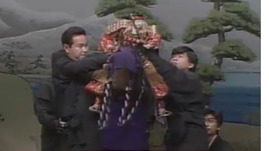Teachers' Domain - Digital Media for the Classroom and Professional Development
User: Preview



In this excerpt from a documentary on Bunraku, students meet an apprentice studying to be a puppeteer at Bunraku Theater in Osaka. In addition, they learn a little bit about the history of this classic Japanese art form and see puppets being manipulated.
Find additional arts resources for your classroom at the KET Arts Toolkit website.
Bunraku, Noh, and Kabuki are three classical stage arts of Japan. Around the 11th century, puppets were used in religious ceremonies and became a popular form of entertainment. Bunraku developed from this weaving of puppetry, music, and storytelling for a unique dramatic presentation.
Traditional Japanese Bunraku (also called Banraku) features elaborate costumes, intricate movements, traditional music, and epic stories. The puppeteers are dressed in black and are in full view to the audience. However, the puppeteers are so skilled that the viewers tend to forget that they are watching a puppet show. Bunraku puppets are very intricate and can be almost five feet tall! Three people manipulate each puppet. The “master” manipulates the head. The puppeteers study as apprentices for many years to gain mastery. An apprentice begins with the study of the leg movements. The master puppeteer may have up to 25 years of training.
Children are not the primary audience of Bunraku theater. The subject of a Bunraku play is usually dramatic and tragic and features aristocrats and samurai warriors. The stories reflect the codes and legends of Japanese culture. Bunraku plays are accompanied by the music of traditional Japanese instruments. Takemoto Gidayu established the first theater devoted to Bunraku in 1684. This art form continues today. The Bunraku National Theater is in Osaka, Japan.
 Loading Standards
Loading Standards